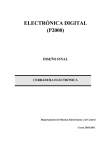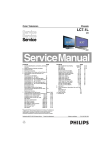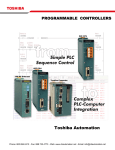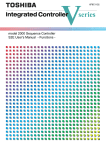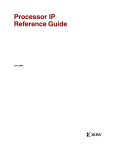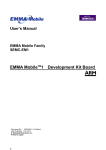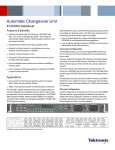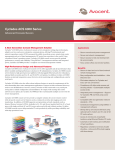Download SPG8000 Master Sync / Clock Reference
Transcript
xx ZZZ SPG8000 Master Sync / Clock Reference Generator Declassification and Security Instructions www.tektronix.com *P077075000* 077-0750-00 Copyright © Tektronix. All rights reserved. Licensed software products are owned by Tektronix or its subsidiaries or suppliers, and are protected by national copyright laws and international treaty provisions. Tektronix products are covered by U.S. and foreign patents, issued and pending. Information in this publication supersedes that in all previously published material. Specifications and price change privileges reserved. TEKTRONIX and TEK are registered trademarks of Tektronix, Inc. Contacting Tektronix Tektronix, Inc. 14150 SW Karl Braun Drive P.O. Box 500 Beaverton, OR 97077 USA For product information, sales, service, and technical support: In North America, call 1-800-833-9200. Worldwide, visit www.tektronix.com to find contacts in your area. Table of Contents Preface .............................................................................................................. Clear and sanitize procedures ..................................................................................... Memory devices ............................................................................................... Troubleshooting.................................................................................................... How to clear or sanitize a nonfunctional instrument...................................................... How to recover from clearing or removing memory from the instrument ............................. SPG8000 Declassification and Security Instructions iii 1 1 13 13 13 i Table of Contents ii SPG8000 Declassification and Security Instructions Preface This document describes how to clear or sanitize the data storage (memory) devices in the products listed below. The instructions also describe how to declassify an instrument that is not functioning. These procedures are useful for customers with data security concerns. Products This document applies to the following components of the SPG8000 Master Sync / Clock Reference Generator: SPG8000 base generator Option DPW (second hot-swappable redundant (backup) power supply) Option GPS (GPS master clock synchronization) Option BG (2 channels of composite NTSC/PAL black or HD tri-level outputs, plus 2 channels of composite NTSC/PAL test signal outputs) Option SDI (2 channels of SD/HD SDI test signal generation on 2 outputs each) Option 3G (3G SDI format support; Option SDI required) Option AG (DARS output; 2 AES/EBU channels plus 4 audio tone outputs; 8 AES/EBU channels) Required documents To perform the procedures in this document, you will need to have access to the SPG8000 manuals listed below. These manuals are available on the Tektronix Web site at www.tektronix.com/downloads. SPG8000 Quick Start User Manual (Tektronix part number 071-3080-XX; 077-0745-XX, Japanese; 077-0746-XX, Russian) SPG8000 Service Manual (Tektronix part number 077-0749-XX) SPG8000 Declassification and Security Instructions iii Preface Terms The following terms may be used in this document: Clear. This removes data on media/memory before reusing it in a secured area. All reusable memory is cleared to deny access to previously stored information by standard means of access. Erase. This is equivalent to clear. Media storage/data export device. Any of several devices that are used to store or export data from the instrument, such as a USB port. Nonvolatile memory. Data is retained when the instrument is powered off. Power off. Some instruments have a “Standby” mode, in which power is still supplied to the instrument. For clearing data, putting the instrument in Standby mode does not qualify as powering off. For these products, you must either push a rear-panel OFF switch or remove the power source from the instrument. Remove. This is a physical means to clear the data by removing the memory device from the instrument. Instructions are available in the product Service Manual. Sanitize. This eradicates the data from media/memory so that the data cannot be recovered by other means or technology. This is typically used when the device is moved (temporarily or permanently) from a secured area to a nonsecured area. User-modifiable. The user can write to the memory device during normal instrument operation, using the instrument interface or remote control. iv SPG8000 Declassification and Security Instructions Clear and sanitize procedures Memory devices The following tables list the volatile and nonvolatile memory devices in the modules. Detailed procedures to clear or sanitize these devices are shown following the tables. Table 1: Volatile memory devices for the SPG8000 base generator Type and minimum size Function Power PC PPC440EPX Main processor MT47H64M16 64Mx16 DDR2 SDRAM Type of user data Backed up by battery Method Data of input modification method Location User accessible Data and settings No Indirectly UI, remote, input signals Main / U1 Yes Set power on preset to factory, cycle power Repeat clear process three times Processor memory Data and settings No Indirectly UI, remote, input signals Main / U33, U34 Yes Set power on preset to factory, cycle power Repeat clear process three times 5M240ZTQFP144 CPLD Decodes signals from the processor to generate control lines for the slots, front panel, and devices on the board. Registers control aspects of the decoding. Settings No Indirectly UI, remote, input signals Main / U220 Yes Set power on preset to factory, cycle power Repeat clear process three times EP4CE6BGA256 FPGA, 270Kbits embedded memory Phase lock loop control, DDS Clock sine wave gen uses some of embedded volatile memory. Settings No Indirectly UI, remote, input signals Main / U450 No Set power on preset to factory, cycle power Repeat clear process three times 88E1116R gigabit ethernet RGMII transceiver 10/100/1000 Ethernet PHY control registers, integrated data FIFO buffer Data No Indirectly UI, remote Main / U58 No Set power on preset to factory, cycle power Repeat clear process three times DAC5571A 8-bit DAC Display Contrast voltage control Settings No Indirectly UI or remote Main / U43 Yes Set power on preset to factory, cycle power Repeat clear process three times SPG8000 Declassification and Security Instructions To clear To sanitize 1 Clear and sanitize procedures Table 1: Volatile memory devices for the SPG8000 base generator (cont.) Type and minimum size Function Type of user data Backed up by battery Method Data of input modification method Location User accessible To clear To sanitize 5M240ZTQFP100 CPLD volatile keypad read-back and LED drive control registers Settings No Indirectly UI or remote Front panel / U1 Yes Set power on preset to factory, cycle power. Repeat clear process three times. Real Time Clock + 128x8 serial NV memory The RTC function is not accessible but the clock runs and will show the elapsed time since the board was built. The memory is used to store user network parameters. Data and settings Yes Direct and indirect UI or remote Main / U16 Yes Perform the clear network settings procedure. There is no way to clear the real time clock. Remove part or battery. FPGA EP2C5F256C7N with internal registers Used to store instrument settings Settings No Indirectly UI GPS/Genlock/Black No board, U432 Restore factory settings Disconnect inputs then Restore factory settings three times FPGA EP2C35F672C6N with internal registers Used to store instrument settings Settings No Indirectly UI GPS/Genlock/Black No board, U732 Restore factory settings Disconnect inputs then Restore factory settings three times 2 SPG8000 Declassification and Security Instructions Clear and sanitize procedures Table 2: Nonvolatile memory devices for the SPG8000 base generator Type of user information Method of Data input stored modification method Location User Accessible To clear To sanitize Type and minimum size Function Serial EEPROM AT24C01B 128x8 Processor boot configuration data None None Factory JTAG Main / U21 No N/A Remove part from board and destroy. NOR Flash PC28F512P30 64Mx16 Main storage for processor. Contains Operating system, application programs, MAC address, instrument family type, FPGA programming files, signal, logo, text overlay and picture files. Both data and settings Directly and indirectly Presets are saved from UI, files and presets are saved from USB or ethernet. Main / U101, U102 Yes Perform the delete presets and user files from memory procedure. Remove part from board and destroy. NAND Flash K9F1G08U0A 128Mx8 Not used. None None None Main / U103 No N/A N/A Serial MRAM MR25H256 32Kx8 Oven calibration data Settings Indirectly Perform calibration Main / U22 Yes Perform calibration Remove part from board and destroy. Settings Indirectly Software upgrade Main / U220 No N/A N/A Decodes signals CPLD, 5M240ZTQFP144, from the processor to generate control 8192 bits flash lines for the slots, front panel, and devices on the board. NV flash is not used Serial EEPROM AT24C01B 128x8 Run time data for power supply showing time of use and temperature / time related use Data Indirectly Automatic over time U1 on Power Supply module; also on Option DPW secondary Power Supply module Yes None Remove parts from board and destroy; can also remove supply from instrument and leave it in a secured area; replace supply with one that has not been in a secure area CPLD 5M240ZTQFP100, 8192 bits flash memory not used Interfaces with signals from the main PLD, drives LEDs and reads the buttons. nonvolatile flash memory is not used. Settings Indirectly Software upgrade Front panel / U1 No N/A N/A SPG8000 Declassification and Security Instructions 3 Clear and sanitize procedures Table 2: Nonvolatile memory devices for the SPG8000 base generator (cont.) Type of user information Method of Data input stored modification method Type and minimum size Function Flash memory 4MX8 Configuration of FPGA None Flash memory 4MX8 Calibration for the module Settings Stores leap second information Flash memory 4MX8 Unused None None Location User Accessible To clear To sanitize None N/A Written by processor system from Main board GPS/Genlock/Black board, U0331 No The values are a function of how the user calibrates the module and when it was last receiving the GPS signal Stored during calibration GPS/Genlock/Black board, U0332 Yes None None No customer information is stored in this flash memory Manually calibrate the module back to the factory default values Stores leap second information obtained by satellite Allow the module to receive satellite information for 30 minutes to update the leap second field GPS/Genlock/Black board, U0741 No None Remove and destroy the memory device or destroy the entire board None Table 3: Nonvolatile memory devices for Option GPS Type and minimum size GPS receiver assembly 1 4 Function May contain user data 1 Calculates timing and position information Yes if operated in fixed mode Data input method Location is stored when operated in fixed mode Location To clear To sanitize Mounts above the main module board and connects to J12 with a ribbon cable, and to the antenna connector on the rear panel Save a position from a location different from the one that was last saved. This will erase the previous position and save the new one Remove and destroy the module or destroy the entire board During normal instrument operation. SPG8000 Declassification and Security Instructions Clear and sanitize procedures Table 4: Volatile memory devices for Option BG Type and minimum size Function Type of user data Backed up by battery Method Data of input modification method Location User accessible To clear To sanitize PLD EPM7128A with internal registers Used to store instrument settings Settings No Indirectly UI Option BG Black board, U300 No Restore factory settings Disconnect inputs then Restore factory settings three times FPGA EPM1K50 with internal registers Used to store instrument settings and to generate test signals Settings No Indirectly UI Option BG Black board, U400 U500 U600 U700 No Restore factory settings Disconnect inputs then Restore factory settings three times SRAM 128K × 36 IDT71V546 Used to store Composite test signals Signals No Indirectly UI selection of format Option BG Black board, U620 U720 No Restore factory settings Disconnect inputs then Restore factory settings three times SPG8000 Declassification and Security Instructions 5 Clear and sanitize procedures Table 5: Volatile memory devices for Option AG Type and minimum size Function Type of user data Backed up by battery Method Data of input modification method Location User accessible To clear To sanitize PLD EPM7128A with internal registers Used to store instrument settings Settings No Indirectly UI Option AG Audio board, U200 No Restore factory settings Disconnect inputs then Restore factory settings three times FPGA EPF10K30 with internal registers Used to store instrument settings and to generate test signals Settings No Indirectly UI Option AG Audio board, U300 No Restore factory settings Disconnect inputs then Restore factory settings three times SRAM 512K × 8 CY7C1049 Used to store audio sine wave signals Signals No Indirectly UI selection of signal Option AG Audio board, U310 No Restore factory settings Disconnect inputs then Restore factory settings three times 6 SPG8000 Declassification and Security Instructions Clear and sanitize procedures Table 6: Nonvolatile memory devices for Option SDI Type and minimum size Flash 32 M x 16 Function FPGA configuration, unique module ID, option key May contain user data 1 Yes Data input method Written by processor system on SPG8000 main board using PLD U226. Location To clear To sanitize 389-4093-00 board, U321 Overwrite the option string with dummy characters. Remove part from board and destroy Option 3G only: User can enter option key string from UI. String must be correct to enable Option 3G. PLD with internal 512 x16 byte user flash memory PLD addresses decoding, memory not used No Programmed at factory 389-4093-00 board, U226 None Remove part from board and destroy DDR2 32 M x 16 Used for frame picture and logo overlay functions Yes Load frame picture and or logo BMP into mainframe, then select frame picture or logo overlay function 389-4093-00 board, U618, U711 Remove power Remove part from board and destroy SRAM 256 K x 16 Used for text and circle overlay functions Yes Load text file to mainframe or enter text string from keyboard 389-4093-00 board U521, U0521, U621, U0621, U622, U0622 If text is saved in power on preset, then should restore factory preset, save as power on preset, then cycle power three times Remove part from board and destroy Dual 2048 step digital potentiometer with EEPROM with the two parts in parallel, limited in software to 100 steps of range Holds calibration data Yes, Indirectly Calibrate output levels 389-4485-00 output board U1 and U5 Store calibration level at mid-scale of 50 Store calibration level at min and max three times then store at mid scale of 50 FPGA with 90 K Logic elements and 4.5 Mb of RAM Generates signals from logic and memory; also used for burn-in timecode Yes, indirectly by signal selection and instrument configuration Programed from flash at bootup, changes state as instrument operates 389-4093-00 board, U811 Remove power Set instrument to power up on factory default and cycle power three times 128 K x 8 EEPROM Unused No None 389-4093-00 board, U224 None Remove part and destroy 1 During normal instrument operation. SPG8000 Declassification and Security Instructions 7 Clear and sanitize procedures To restore the factory default settings Restore the instrument to the factory default settings as follows: 1. Press the SYSTEM button until SYSTEM: PRESET appears. 2. Press the ENTER button. You will see SYSTEM : PRESET : RECALL displayed. 3. Press the left (◄) or right (►) arrow button until Factory Default appears. 4. Press the ENTER button. 5. Press the BACK button to exit the Preset menu. To set the factory default settings as the power on state 1. Perform the previous procedure to restore the factory preset/default state. 2. Press the SYSTEM button until SYSTEM : PRESET appears. 3. Press the ENTER button. You will see SYSTEM : PRESET : RECALL displayed. 4. Press the up (▲) or down (▼) arrow button to select SYSTEM : PRESET : SAVE 5. Press the left (◄) or right (►) arrow button until the display shows SYSTEM : PRESET : SAVE Power On Default. 6. Press the ENTER button. The display will flash as it saves the preset. 7. Press the BACK button to exit the Preset menu. To clear the network settings 1. Press the SYSTEM button until SYSTEM : PRESET appears. 2. Press the up (▲) or down (▼) arrow button to select SYSTEM : NETWORK. 3. Press the left (◄) or right (►) arrow button to select Setup, and then press the ENTER button. 4. Press the up (▲) or down (▼) arrow button to select SYSTEM : NET SETUP : DHCP. 5. Press the left (◄) or right (►) arrow button to select Disable, and then press the ENTER button. NOTE. The DHCP feature must be disabled before you can clear the network settings stored in the instrument memory. 8 SPG8000 Declassification and Security Instructions Clear and sanitize procedures 6. Press the up (▲) or down (▼) arrow button to select SYSTEM : NET SETUP : IP ADDRESS, and then press the ENTER button. 7. Use the left (◄) or right (►) arrow buttons to select each number in the IP address, and use the up (▲) or down (▼) arrow buttons to change the address values to a safe default number such as all zeros. Press the ENTER button to save the changes. 8. Repeat steps 6 and 7 for the Subnet Mask and Gateway addresses. 9. Press the BACK button to exit the NETWORK submenu. To delete presets and user files from memory Backup existing presets or user files. If you want to backup your presets or user files before you delete them so that you can restore them at a later time, perform the following steps. Otherwise, proceed to step 12. 1. Connect a USB drive to the SPG8000 generator. 2. Press the SYSTEM button to select SYSTEM : PRESET. 3. Verify the status of the USB drive: a. Press the up (▲) or down (▼) arrow button to select SYSTEM : USB (status). b. Verify that the USB status is Mounted. c. If the status is Not Mounted, press the ENTER button to mount the USB drive. 4. Press the up (▲) or down (▼) arrow button to select SYSTEM : BACKUP/RESTORE. 5. Press the left (◄) or right (►) arrow button to select one of the following: Backup Presets to USB: Backs up only the instrument presets to the USB drive. If you are backing up only presets, you will need up to 1 MB of free space on the USB drive. Backup All User Data to USB: Backs up all user data to the USB drive. When all user data is backed up, every user file except for the FPGA configuration files will be copied to the USB drive. User files are defined as any file that exists in the /app/F0 directory on the instrument. The files in this directory can include presets, signal files, frame picture files, logo files, sequence files, and for Option SDI and Option 3G, can also include text and font files. The user data files do not include the application software or any Linux files. NOTE. If you are backing up all of the user data in the instrument, you will need up to 96 MB of free space on the USB drive. SPG8000 Declassification and Security Instructions 9 Clear and sanitize procedures 6. Press the ENTER button to start the selected backup operation. 7. A warning message is displayed asking you to verify the operation. Press the ENTER button to proceed or press the BACK button to cancel the operation. 8. Monitor the progress of the file copy operation: a. During the first stage of the copy process, the display shows the names of the files as they are copied. Depending on the size of the files being copied, this may take a couple of minutes. b. When all of the files have been copied, the message “Finishing copy...” is displayed while the file system buffers are emptied. This message may appear for a couple of minutes. c. When the backup operation is complete, the message “Backup completed successfully” is displayed before the menu display returns to normal. NOTE. If the USB drive runs out of memory before the backup operation is complete, the operation will copy as much data as it can and will then display an error message stating that the backup operation was incomplete because the drive or device is full. Press the ENTER or BACK button to clear the error message. 9. After the backup operation is complete, press the up (▲) or down (▼) arrow button to select SYSTEM : USB (Mounted). 10. Press the ENTER button to unmount the USB drive. After the message “You may now safely remove the USB drive” is displayed, the menu readout should change to SYSTEM : USB (Not mounted). 11. Remove the USB drive from the instrument. Delete the presets and user files from the instrument. 12. Connect the instrument and a computer using an Ethernet connection as described in the SPG8000 Quick Start User Manual. 13. On the computer, open an FTP client such as Windows Explorer. 14. In the Windows Explorer command box, enter “ftp://IP address”, where IP address is the network address assigned to the TG8000 generator. NOTE. Some FTP clients may ask for login credentials. In this case, login with a user name of “anonymous” and no password. 10 SPG8000 Declassification and Security Instructions Clear and sanitize procedures 15. The Windows Explorer window should immediately connect to the instrument and show the directory structure as shown below. Figure 1: Example FTP view of the instrument file structure 16. In the CPU directory, delete any preset files. 17. In the SEQUENCE directory, delete any sequence files. 18. In each of the module directories, delete all of the preset files and any user-created picture, logo, text, or signal files. NOTE. In addition to the user-created files, the module directories will also contain the factory default files for the standard signals and logos that are supplied with the instrument. You do not need to delete the factory default files. 19. After you have deleted the desired files, close the FTP window. SPG8000 Declassification and Security Instructions 11 Clear and sanitize procedures 12 SPG8000 Declassification and Security Instructions Troubleshooting How to clear or sanitize a nonfunctional instrument To sanitize a nonfunctional instrument, remove the Main board, GPS/Genlock/Black board, SDI board, and all Power Supply modules, and then return the instrument to Tektronix for installation of new boards and modules. How to recover from clearing or removing memory from the instrument The procedure to recover from clearing or removing memory depends on whether the memory was on a generator card or on the instrument mainframe. Perform the appropriate procedure as described in this section. To recover from clearing or removing memory from a generator card Perform the following procedure to recover a generator card: 1. Power on the instrument. 2. Calibrate the generator card as instructed in the SPG8000 Service Manual. 3. Reconfigure the generator card for your specific application. You can find configuration information in the SPG8000 Quick Start User Manual. 4. For Option GPS only: a. Connect a GPS signal to the generator card and let it run for 30 minutes. This allows the leap second and position information to be reacquired. b. You are finished with the Option GPS recovery; the GPS generator card will reload the system software on start up. 5. For Option SDI only, verify that Option 3G is enabled: NOTE. You need to perform the following steps only if the instrument had Option 3G enabled prior to being sanitized. a. Press the SYSTEM button. b. Press the up (▲) or down (▼) arrow button to select SYSTEM : OPTIONS. c. The second line of the display lists the enabled options. Check that 3G is displayed. e. If Option 3G is not enabled, you must reenter the option key for Option 3G as described in the SPG8000 Quick Start User Manual. SPG8000 Declassification and Security Instructions 13 Troubleshooting To recover from clearing or removing memory from the SPG8000 base instrument Perform the following procedure to recover the SPG8000 base instrument: 1. Power on the instrument. 2. Calibrate the mainframe oscillator oven as instructed in the SPG8000 Quick Start User Manual. To calibrate the oscillator, you can use a GPS signal if Option GPS is installed. Otherwise, you can use a 10 MHz signal or a video reference signal that is known to be at a precise frequency. 3. Configure the network parameters for the instrument as instructed in the SPG8000 Quick Start User Manual. 4. If you backed up the presets and user data files onto a USB drive before you removed the mainframe memory, restore the presets or user data files as described below: a. Connect the USB drive to the SPG8000 generator that you used to back up the presets or user data files. b. Press the SYSTEM button to select SYSTEM : PRESET. c. Press the up (▲) or down (▼) arrow button to select SYSTEM : USB (status). d. Verify that the USB status is Mounted. e. If the status is Not Mounted, press the ENTER button to mount the USB drive. f. Press the up (▲) or down (▼) arrow button to select SYSTEM : BACKUP/RESTORE. g. Press the left (◄) or right (►) arrow button to select Restore Presets from USB or Restore All User Data from USB. h. Press the ENTER button to start the selected restore operation. i. A warning message is displayed asking you to verify the operation. Press the ENTER button to proceed or press the BACK button to cancel the operation. j. During the first stage of the copy process, the display shows the names of the files as they are copied. Depending on the size of the files being copied, this may take a couple of minutes. k. When all of the files have been copied, the message “Finishing copy...” is displayed while the file system buffers are emptied. This message may appear for a couple of minutes. l. 14 When the restore operation is complete, the message “Restore completed successfully” is displayed before the menu display returns to normal. SPG8000 Declassification and Security Instructions Troubleshooting m. After the restore operation is complete, press the up (▲) or down (▼) arrow button to select SYSTEM : USB (Mounted). n. Press the ENTER button to unmount the USB drive. After the message “You may now safely remove the USB drive” is displayed, the menu readout should change to SYSTEM : USB (Not mounted). o. Remove the USB drive from the instrument. 5. If you did not restore the presets or user data files from a USB drive in step 4, then adjust the display contrast as follows: a. Press the SYSTEM button to select SYSTEM : PRESET. b. Press the up (▲) or down (▼) arrow button to select SYSTEM : LCD CONTRAST. c. Press the left (◄) or right (►) arrow button to set the display contrast to the desired level. NOTE. Perform the following steps if you want to save the display contrast setting so that it will be restored when the instrument is powered on. d. Press the SYSTEM button to select SYSTEM : PRESET, and then press the ENTER button. e. Press the up (▲) or down (▼) arrow button to select SYSTEM : PRESET : SAVE. f. Press the left (◄) or right (►) arrow button to select Power On Default. g. Press the ENTER button to save the current instrument settings as the power on default. SPG8000 Declassification and Security Instructions 15






















